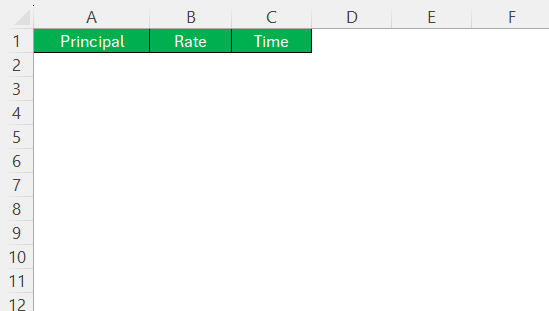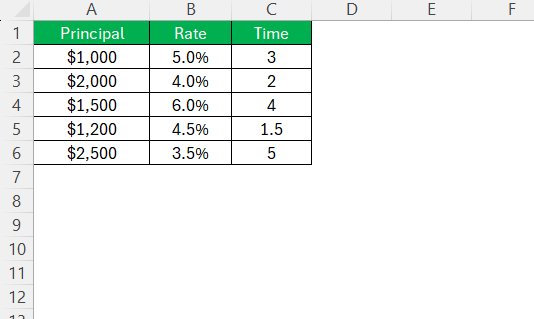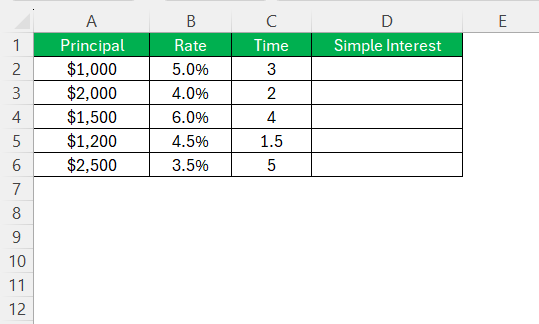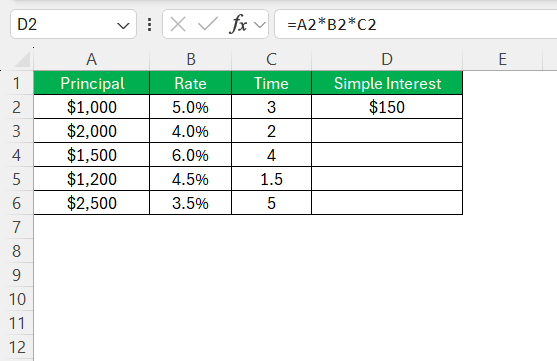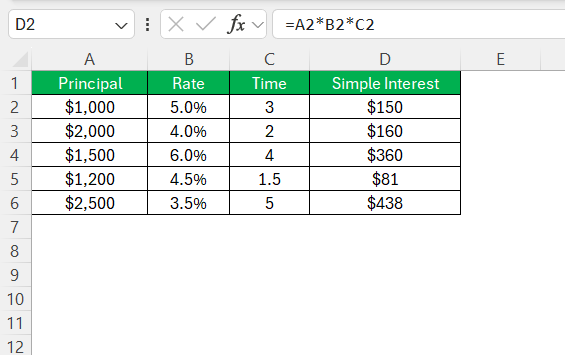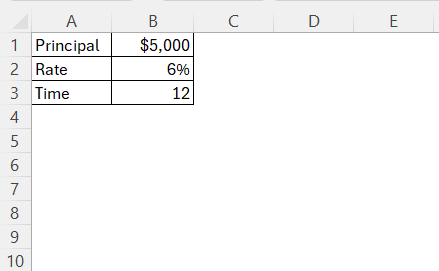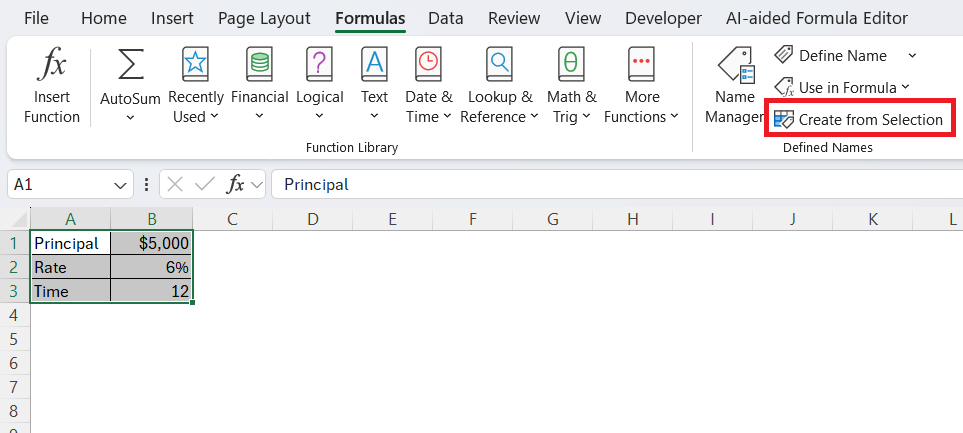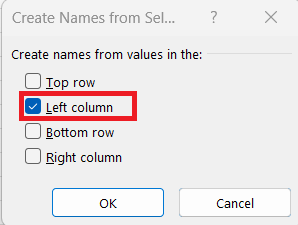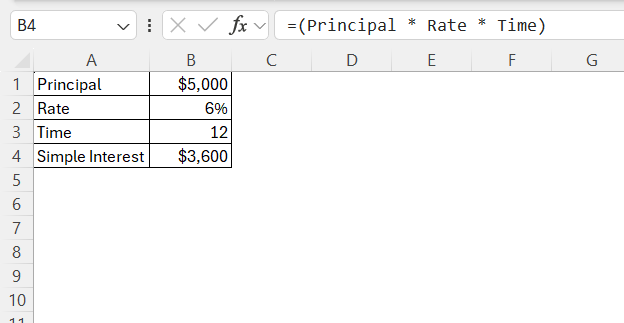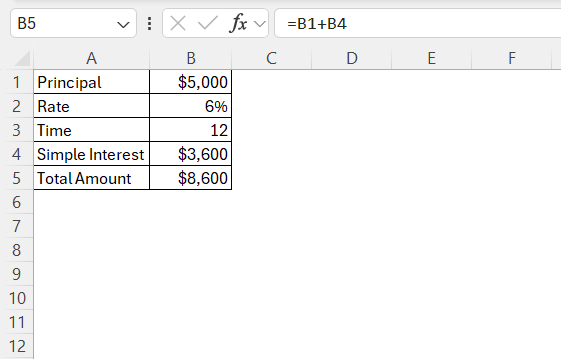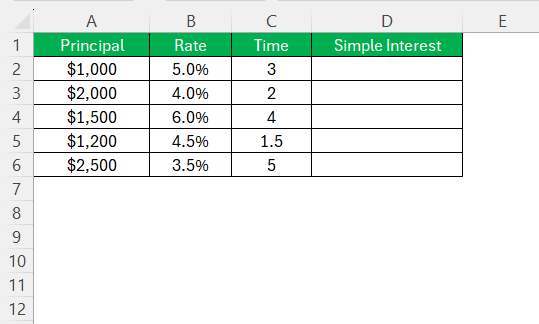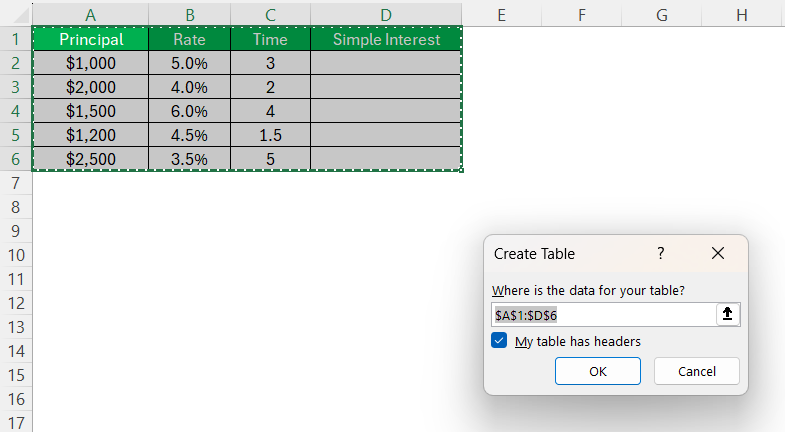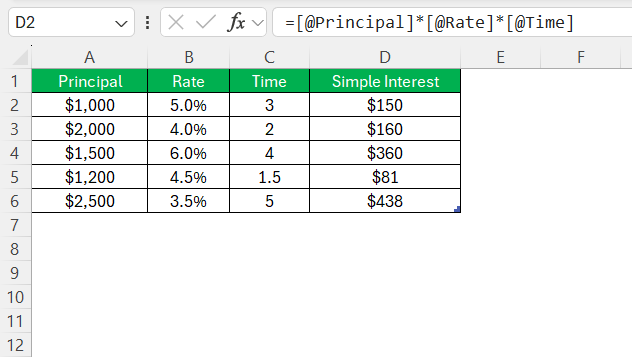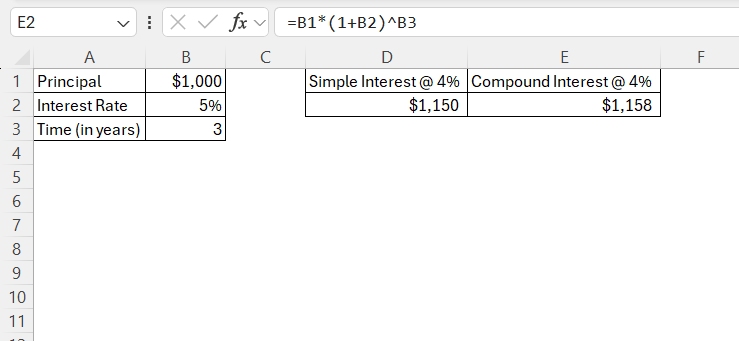Mastering the art of simple interest calculations not only streamlines personal and business finances but also enhances one’s ability to make informed financial decisions. In today’s digital age, leveraging tools like Excel can make this task even more efficient. Whether you’re a student, a professional, or a financial enthusiast, understanding how to calculate simple interest using Excel could be a game-changer.
Key Takeaways:
- Simple interest is easy to understand and helps in making informed financial decisions for loans and investments.
- The formula for simple interest is SI = (Principal × Rate × Time) / 100, and it’s based only on the original amount.
- Excel makes calculating simple interest efficient using basic formulas, named ranges, and tables for automation.
- Knowing how to compare simple and compound interest helps evaluate financial options and long-term outcomes.
- Simple interest calculations are valuable in personal finance, education, and business forecasting for better planning.
Table of Contents
Mastering Simple Interest Calculations
Understanding the Simple Interest Formula
Simple interest serves as the cornerstone for many basic financial problems, offering a straightforward method for estimating the cost of borrowing or the return on investment. The simple interest formula is expressed as:
Simple Interest (SI) = (Principal × Interest Rate × Time) / 100
- Principal (P): This is the initial amount of money that is either borrowed or invested.
- Interest Rate (R): Usually represented as an annual percentage, it indicates the cost of borrowing or the profit from investment.
- Time (T): Measured in years, this is the duration for which the principal is borrowed or invested.
The elegance of the simple interest formula lies in its simplicity. It computes interest based solely on the principal sum, unlike compound interest, which considers the accrued interest. Thus, understanding this formula is fundamental for anyone aiming to effectively manage loans, investments, or savings.
Setting Up Your Excel Spreadsheet for Interest Calculation
Creating a simple interest calculator in Excel is a straightforward process that can help automate and simplify financial calculations. Here’s a step-by-step guide:
STEP 1: Label the first three columns as “Principal,” “Rate,” and “Time.”
STEP 2: Enter the principal amount in the first column. Input the interest rate in the second column, using decimal form (e.g., 5% as 0.05). Fill in the time period in years in the third column.
STEP 3: Label the fourth column as “Simple Interest.”
STEP 4: In the first cell under “Simple Interest,” enter the formula =A2*B2*C2 (adjust cell references if needed).
STEP 5: Drag the formula down for all rows: Hover over the bottom-right corner of the formula cell until a small square (fill handle) appears, then click and drag it down to apply the formula to other rows.
By performing these steps, you transform Excel into a powerful tool for calculating simple interest without having to manually redo calculations each time new data is introduced. You can add more rows and columns as needed to accommodate different scenarios or multiple data entries.
This structured approach not only saves time but also reduces the potential for manual errors, allowing you to focus on analyzing results rather than computation.
Tips & Tricks
Using Named Ranges for Clarity
As I started working with larger sheets or explaining interest calculations to others, I realized that named ranges can make formulas more readable.
Here’s how I do it:
STEP 1: Enter Principal, Rate, and Time in a table.
STEP 2: Select the entire data and go to Data > Create form Selection.
STEP 3: In the dialog box, check ‘Left Column’.
STEP 4: Then in B4, I simply use:
=(Principal * Rate * Time)
It’s cleaner and easier to understand at a glance.
Calculating Total Amount Payable
To see the total amount (Principal + Interest), I add one more row to my sheet:
Total Amount =B1 + B4
This tells me how much I need to repay or what I’ll receive at the end of the investment period.
Automating Repeated Calculations with Tables
Sometimes I need to calculate interest for multiple scenarios—maybe different loan amounts or time durations. That’s when I use Excel’s built-in Table feature:
STEP 1: I list out various principal amounts, interest rate, and time in different columns.
STEP 2: Select the entire data and press Ctrl + T to create a table.
STEP 3: I apply the formula across rows using structured references.
=[@Principal]*[@Rate]*[@Time]
STEP 4: Drag the formula down.
Tables make everything neater, and formulas automatically extend when I add new rows.
Advanced Excel Techniques for Interest Calculation
Comparing Simple vs. Compound Interest
Imagine two paths diverging in a financial forest: one leads to Simple Interest, and the other, to Compound Interest. Simple interest is straightforward, calculating interest solely on the principal amount. On the other hand, compound interest takes a more adventurous route, calculating interest on the principal plus any previously earned interest.
Compound Interest = P × (1 + r/n)^(n × t)
This distinction is crucial in long-term investments or loans where compound interest can significantly increase the amount of interest earned over time.
For instance, consider a $1,000 investment at a 5% annual interest rate over three years. In simple interest, the total earned will be $150, while compound interest yields $157.63, assuming compounding annually. The decision between these two methods hinges on financial goals, time frame, and risk appetite.
The main differences between simple and compound interest are the interest you’ll pay in the long run and the duration over which you’ll pay it. Simple interest is a one-time charge based on principal and term, whereas compound interest continually calculates based on the principal, term, and existing interest. Beyond loans, these concepts apply to investment and savings strategies, influencing how significantly one’s wealth can grow over time.
Although easy to understand and calculate, simple interest rarely appears in real-world financial scenarios where compound interest typically prevails. Compound interest involves adding interest to the principal balance after each period, meaning the amount of interest earned or paid will increase over time due to this “interest on interest” effect.
Real-World Applications and Scenarios
Personal Finance Management Tips
Using simple interest calculations in Excel can dramatically improve personal finance management by providing a clear picture of how your money is working for you. Here are some practical tips to get started:
- Evaluate Loan Options: Use simple interest to compare different loan offers. By inputting the principal, interest rate, and duration of each loan, you can quickly see which option results in lower interest payments.
- Track Savings Growth: For savings accounts that use simple interest, regularly update your Excel sheet with current rates and time periods to track how much interest your deposits are earning over time.
- Budget for Major Expenses: Calculate potential interest on future credit purchases. This helps in understanding the additional cost for items purchased on credit, aiding in effective budgeting.
- Debt Reduction Planning: Input credit card balances and calculate monthly interest accrual. This visibility can motivate timely repayments and help strategize debt reduction.
- Transparency in Financial Goals: Clearly outline your financial goals and use Excel to simulate various interest rate scenarios, helping prioritize savings efforts and ensuring more informed financial decisions.
By consistently utilizing these straightforward Excel strategies, you can gain a better grasp of your financial situation, make strategic decisions, and ultimately foster a greater sense of financial security and foresight. Whether it’s fine-tuning your budget, optimizing savings strategies, or comparing loans, mastering simple interest calculations in Excel provides the clarity needed to achieve your personal finance goals.
Enhancing Educational Projects with Simple Interest Calculations
Incorporating simple interest calculations into educational projects transforms abstract mathematical concepts into tangible, real-world applications, thereby enriching students’ learning experiences. Here are some innovative ways to enhance projects:
- Interest Rate Impact Analysis: Create projects that investigate how altering interest rates affects savings or loan costs over time. This helps students visualize the cumulative impact of seemingly small rate changes.
- Interactive Simulations: Use Excel to build dynamic models where students can input different principal amounts, rates, and times to see instant results on calculated interest. This hands-on approach reinforces the learning experience.
- Financial Literacy Workshops: Organize group activities where students use simple interest calculations to solve real-world problems, such as calculating the total cost of a car loan. This encourages collaboration and practical application.
- Historical Interest Rates Study: Task students with researching historical interest rate trends and using Excel to chart their impact on savings accounts or loans over the decades. This fosters research skills and historical awareness.
- Comparative Analyses: Encourage students to compare simple and compound interest calculations in different scenarios, facilitating a deeper understanding of the benefits and limitations of each.
By embedding simple interest calculations into educational projects, students not only engage more thoroughly with mathematical concepts but also gain essential life skills in financial literacy. These projects promote critical thinking, analytical skills, and the ability to apply theoretical knowledge in practical settings, preparing students for future financial challenges and enabling them to make informed decisions.
Business Analysis and Financial Forecasting
Simple interest calculations are indispensable tools in business analysis and financial forecasting, providing clarity and precision to a company’s financial strategies. Here’s how businesses can leverage these calculations:
- Cost of Capital Assessment: Determine the cost of short-term loans used in business operations by calculating the simple interest. This helps forecast the impact of debt on cash flow and profitability.
- Investment Evaluations: Use simple interest to project potential returns on business investments. By comparing these projections with expected returns from alternative investments, businesses can make informed strategic decisions.
- Cash Flow Projections: Include interest accrued on fixed deposits or lines of credit in cash flow forecasts. This gives a more holistic view of future cash availability, crucial for planning expansions or urgent expenses.
- Pricing Models and Strategies: Employ simple interest to determine interest charges for customer financing options, influencing pricing models and enhancing competitive strategies.
- Seasonal Financial Planning: Calculate interest on seasonal investments or loans to optimize resource allocation during peak business cycles, ensuring liquidity and operational efficiency.
Incorporating simple interest calculations into business analysis and forecasting enables companies to optimize resources, mitigate financial risks, and align strategic goals with market conditions. By equipping decision-makers with clear and accurate financial insights, businesses can improve their agility and responsiveness to changing economic environments.
This precision in forecasting and analysis not only strengthens financial health but also enhances competitive advantage by enabling more informed and strategic decision-making.
FAQs
What is simple interest?
Simple interest is a method of calculating the interest charge on a loan or investment based on the principal amount only. It does not factor in the effect of compounding, meaning the interest is not added to the principal at regular intervals. This straightforward approach makes it ideal for short-term financial calculations or situations where constant interest over time is beneficial.
What is the formula for calculating simple interest?
The formula for calculating simple interest is:
Simple Interest (SI) = (Principal × Interest Rate × Time) / 100
Here, the principal is the initial amount of money, the rate is the annual interest rate expressed as a decimal, and the time is the period for which the money is borrowed or invested, typically in years.
How can I set up a simple interest calculator in Excel?
To set up a simple interest calculator in Excel, start by labeling columns for “Principal,” “Rate,” and “Time.” Enter your values in these columns. In a new column labeled “Simple Interest,” input the formula =A2*B2*C2 (adjust cell references as needed). This formula multiplies the principal by the rate and time to calculate the simple interest.
What are common mistakes when calculating interest in Excel?
Common mistakes in Excel interest calculations include incorrect data entry, such as typos in figures, and misunderstanding interest rate units. Failing to format cells properly or mixing up simple and compound interest formulas also leads to errors. Ensuring your formulas and data align precisely can prevent these pitfalls.
How do you calculate compound interest?
To calculate compound interest, use the formula:
Compound Interest = P × (1 + r/n)^(n × t)
Here, ( P ) is the principal amount, ( r ) is the annual interest rate expressed as a decimal, ( n ) is the number of times interest is compounded per year, and ( t ) is the time in years. This formula accounts for interest on previously earned interest, increasing the total amount accrued over time.
John Michaloudis is a former accountant and finance analyst at General Electric, a Microsoft MVP since 2020, an Amazon #1 bestselling author of 4 Microsoft Excel books and teacher of Microsoft Excel & Office over at his flagship MyExcelOnline Academy Online Course.

